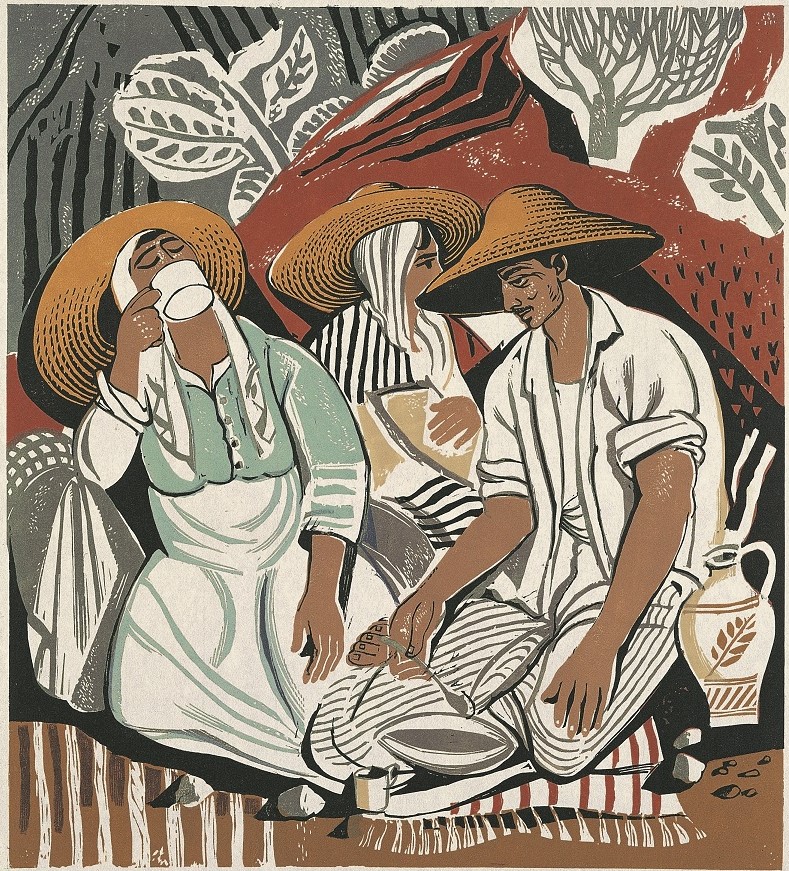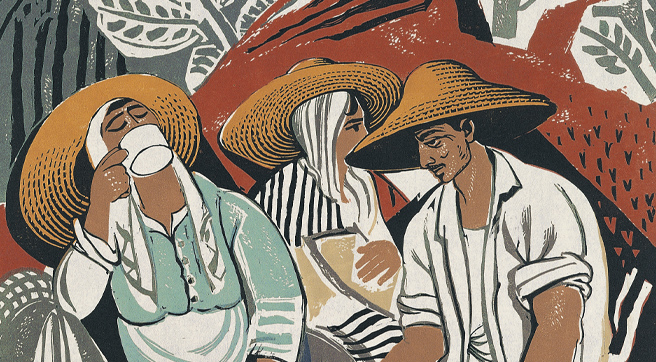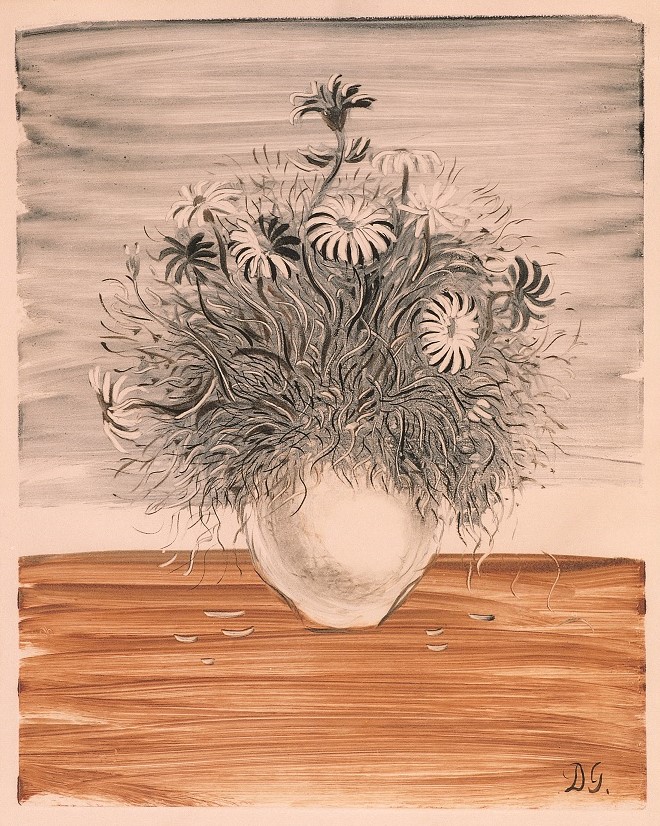A. Tassos, Noon
Noon is a colour woodcut by prominent Greek engraver A. Tassos. A student of the famous Jean Kefalinos, Tassos stood out for his woodcuts and work in graphic arts. His multifaceted work was characterised by his technical abilities. His intense engagement in social issues is evident through the entire range of his artistic production.
Farming in art
3 human figures dominate the composition: 2 female and 1 male. The background is a lush landscape.
The print depicts farmers in Messinia, wearing the distinctive broad-brimmed straw hats. The moment that is captured is the time of rest – a short break from the arduous work on the hard Peloponnesian soil.
Stern technique and sensitive realism
The colour palette plays with the tones of ochre, warm brown, dark red and cyan. Their alternate use creates a dialogue of cold and warm grades, which add clarity and vividness to the piece.
The artist renders the simple, everyday utensils with special descriptive details and tenderness. The same holds true for the stance of the bodies, and the expressions on the faces of the people.
The print is completely surrendered to Tassos’ experienced hand. This way, he instils the necessary gravity and sternness on the figures.
Despite their hard manual work in adverse conditions, the figures retain a kind of rugged dignity. This stance is directly tied to the starkness of the surrounding landscape.
His life in a nutshell
A. Tassos (Anastasios Alevizos, 1914-1985) was born in Lefkochora, Messinia.
He studied at the Athens School of Fine Arts (1930-1939):
- Painting, under Thomas Thomopoulos, Umberto Argyros and Konstantinos Parthenis.
- Engraving, under Jean Kefalinos, as one of his first students.
During the German Occupation of Greece, he was a member of the Artists’ National Liberation Front. He designed posters and participated in the illustration of resistance albums.
Besides engraving, he also worked extensively and very successfully in graphic arts.
Artistic influences
The main landmarks in Tassos’ career and the shaping of his creative idiom were:
- His acquaintance with the works of Dimitris Galanis, the founder of Greek engraving. The occasion was Galanis’ exhibition at Iliou Melathron in Athens in 1928.
- His apprenticeship under the exceptional engraver and director of the School of Fine Arts, Jean Kefalinos. Kefalinos’ workshop was an incubator for the first generation of major Greek engravers.
- His term as an art consultant at the Aspioti-ELKA Graphic Arts Factory from 1948 until his death in 1985.
Originally his works were influenced by Expressionism. However, when he became familiar with Galanis’ work, he was deeply influenced by his artistic perspective.
Favourite themes
Initially Tassos drew inspiration from the Greek landscape and its particular nature. At the same time, he was interested in urban life. However, the common denominator in all his works was the element of social sensitivity.
During the phase of coloured woodcuts, we turned to rendering the Greek countryside. In this context, he specifically focused on his homeland, Messinia, and its people.
After 1960 the engraver turned to large, austere compositions with symbolic figures. He created series of symbolic and commemorative pieces in 2 periods (White-Black and White-Black 2). During this phase, he worked on:
- Themes with strong social protest elements.
- The recording and visual representation of political events in Greece and Cyprus.
From engraving to graphic arts
In his artistic course, Tassos was focused solely on engraving, and more specifically on woodcuts.
After 1950 and for about a decade, he turned away from black and white woodcuts and started using colour in his prints. He later returned to the style that made him known and was typified by:
- Studied figures.
- Abstract elements.
- Deep influences from Byzantine icon painting.
Tassos was able to combine engraving and graphic arts with remarkable results. Woodcut prints had a defining role in his illustration work. In fact, in 1936, Zacharias Papantoniou had said that Tassos was destined to illustrate books.
Tassos worked on:
- Illustrations of books and albums.
- Posters and pamphlets.
- Postage stamps for Greece and Cyprus.
A recognised artist
Tassos is considered one of the top Greek engravers of the post-war era.
In 1954 he started working with the Hellenic Post to design postage stamps. He ended this collaboration in 1967, when the Greek Junta was established.
However, he designed all the postage stamps for the Republic of Cyprus from 1962 until his death in 1985.
With the exception of the Junta period, Tassos held important solo exhibitions. Top among them was the exhibition at the National Gallery in 1975, which attracted many visitors.
The National Gallery also honoured the artist with a large retrospective exhibition in 1987. Today it boasts the most complete collection of his works.
A. Tassos and Alpha Bank
The collaboration between Alpha Bank and Tassos started in 1964 and continued until the end of his life. Between 1971 and 1980 the engraver was the art director for all Alpha Bank publications.
He also worked as a commissioned artist. One of his commissioned pieces was the portrait of the Alpha Bank founder, Ioannis F. Costopoulos, based on a painting by G. Iakovidis.
The Alpha Bank Art Collection also includes an edition of Epitaphios by Yannis Ritsos illustrated with Tassos’ prints.
The work of art in our publications
The piece Noon by A. Tassos is referenced in the following Alpha Bank publications:
- The Alpha Bank Collection. Paintings – Prints – Sculptures, edited by Irene Orati. The publication marks the 125th anniversary of Alpha Bank.
Buy the publication The Alpha Bank Collection. Paintings – Prints – Sculpture (only available in Greek) on the Alpha Bank eshop. - The Alpha Bank Collection. Greek Art from 1920 until Today, edited by Irene Orati. The publication accompanied the Art Collection’s exhibition at the Macedonian Museum of Contemporary Art in Thessaloniki.
Buy the publication The Alpha Bank Collection. Greek Art from 1920 until Today on the Alpha Bank eshop. - A. Tassos, edited by Konstantinos Papachristou, Irene Orati, Dimitris Pavlopoulos, Annie Malama, Despoina Tsourgianni. The publication accompanied the retrospective exhibition of A. Tassos held at Benaki Museum (2015-16).
Buy the publication A. Tassos on the Alpha Bank eshop (only available in Greek). - The Alpha Bank Collection. Greek Art from 1950 until Today, edited by Irene Orati. The publication accompanied the exhibition of the Collection at the Rhodes Museum of Modern Greek Art.
The Alpha Bank Art Collection is not open to the public.
Research visits to the Art Collection can be organised upon request.
Contact us to book your visit.







